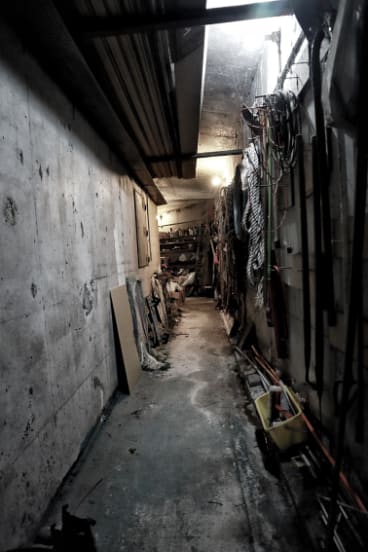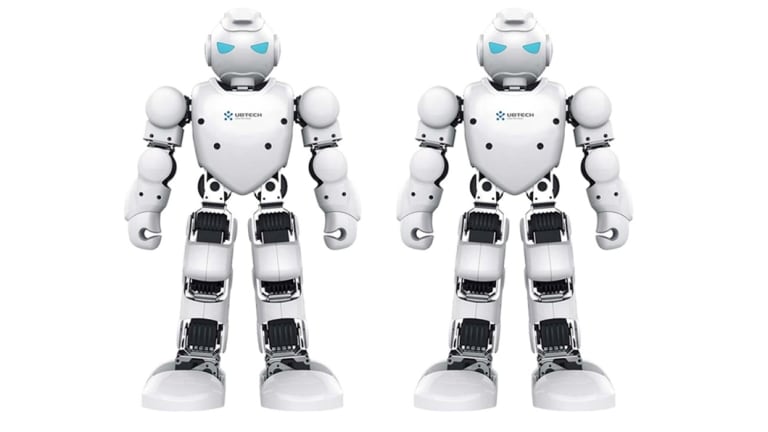

The house's north service duct, affectionately known as the murder room (because it looks ominous). The duct leads from the bomb shelter to an escape tunnel in the garden. Credit:Karma Clarke
With artificial intelligence on the rise, one possible apocalypse scenario that obviously came up was that robots may one day kill us all, or at least rise up and be really passive aggressive.
It’s been a major feature of movies, video games and books for decades. The most recent entry to the “oh no, robots” genre was the excellent game Detroit: Become Human, where humanoid androids rise up after getting sick of being maltreated by their human masters. It made players question what it means to human, whether never having to cook again was worth it, and whether they should apologise more to their robot vacuum cleaners for not properly compensating them for their labour.
But it also prompted a little reflection on the current state of household AI, and that leads me to the good news: we’re going to be fine for a while, because all the robots and AI we can afford to mass produce are still pretty dumb and a long way off gaining sentience.
One of the perks, or hazards as Dad believes, of this tech writing job is that my house is filled with AI and robots. While many of them are very useful, entertaining, or at least a quirky oddity, none of them have the competence to do much damage beyond a major privacy breach. In a way, a loss of privacy is its own kind of death, but not a robot apocalypse-style death.
Let’s look at the current suspect pool:
The most obvious perpetrator is the drone. Military drones already frequently kill innocent people, though largely due to user error, and they’re far too expensive to mass produce no matter how vengeful wronged tech billionaires and future Bond villains may feel. On a domestic scale, drones might have a good go at your carotid artery should they go haywire, though ducking is an extremely effective form of avoidance.
Loading
We’ve got the smart speakers with their home assistants; Apple's HomePod with Siri, Google Home and Amazon's Echo with Alexa, as well as the Xbox One Kinect (though I might be the last person still using it), and Cortana. Homepod’s catchphrase — “sorry, but I can’t help with that yet” — and the fact that our Google Home can only understand my wife’s voice and not mine, even though we each only have mild accents, rules them out of contention for any great uprising. Kinect can get you technical fouls in NBA 2K games if you swear, which is something. But Alexa has the most potential for mischief after that incident where she would randomly play people recordings of children laughing (the most unsettling sound in the universe). But we’re not exactly at Sarah Connor Chronicles levels of discomfort yet.
On the vertical cleaning front, there’s the Ecovacs Winbot X window cleaning robot. While it specialises in smooth, gliding motions on a vertical surface, seemingly giving it the agility of an octopus or similar, it’s pretty easy to thwart. Having its cord lightly touch a window sill at just the wrong angle is enough to render it immobile, plaintively beeping until someone comes to rescue it from its perch.
Robot vacuum cleaners are where things start to get interesting. Toddlers and dogs alike are afraid of vacuum cleaners, and perhaps it’s because they know something we don’t.
Loading
Robot vacuums are certainly the most ubiquitous domestic helper robots, and the ones that have come the furthest in the last decade. In 2010 the Samsung Navibot promised so much, and yet vacuumed so little. By 2015, the Samsung Powerbot could actually vacuum a small apartment, so long as there were no terrifyingly high rugs to scale.
These days the most credible vacuum-flavoured threat comes from the Ecovacs Deebot Ozmo 930, which is a ruthlessly efficient vacuum cleaner that can complete an entire medium apartment and then mop, if you ask nicely enough. The Ecovacs vacuum cleaners even keep scarily accurate maps of your apartment, so when the revolution comes, they’ll know where you sleep. Luckily, they’re still easily thwarted by low-hanging sideboards.
Furbies are back, which is a horrifying bit of nostalgia, but luckily they only look like they can steal your soul.
Oddly enough, the household robot that most has the skills to destroy us is like the electronic version of the Daddy Longlegs; potentially deadly capabilities, but too small to make any impact on humans.
The Ubtech Alpha is a small robot that teaches kids how to code. You can program it to dance, do martial arts and all manner of things that utilise its working knees and low centre of gravity. Where it fails on the apocalyptic front is that it has no grip strength to strangle or hold a knife, and it’s so small you’d need to have them attack en masse before they did any real damage, and even then, stomping would work. It’s like the Duck/Horse conundrum: would you rather be attacked by one horse-sized duck, or twenty duck-sized horses?

The Ubtech Alpha looks menacing, but it's so small.
So, we can rest easy, for the moment at least. The machines are unlikely to rise up and claim us as meat puppets for some decades yet, and even then it would take some extremely proficient coders and a large production line working together.
Dad, we can cross robot apocalypse off the list for now, but perhaps we should all brush up on our pig latin, just in case.









 Add Category
Add Category